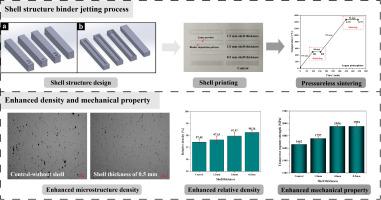当前位置:
X-MOL 学术
›
Int. J. Refract. Met. Hard Mater.
›
论文详情
Our official English website, www.x-mol.net, welcomes your
feedback! (Note: you will need to create a separate account there.)
Enhancing mechanical properties and density of WC-Co with pressureless sintering via shell structure binder jetting additive manufacturing
International Journal of Refractory Metals & Hard Materials ( IF 4.2 ) Pub Date : 2024-07-09 , DOI: 10.1016/j.ijrmhm.2024.106790 Tian Zhang , Yuanqiang Tan , Chao Liu
International Journal of Refractory Metals & Hard Materials ( IF 4.2 ) Pub Date : 2024-07-09 , DOI: 10.1016/j.ijrmhm.2024.106790 Tian Zhang , Yuanqiang Tan , Chao Liu

|
The binder jetting (BJT) additive manufacturing (AM) process is suitable for producing complex WC-Co cemented carbide parts. To achieve near-full-density in the final parts, the hot isostatic pressing (HIP) sintering process is typically employed to enhance densification. However, HIP sintering requires high equipment specifications and is relatively more costly compared to conventional pressureless sintering. To improve the density of WC-Co parts printed by BJT AM under the pressureless sintering environment, the shell structure printing method was used in this study. The shell structure printing only jets binder to the model's outer profile, creating a shell that encapsulates the central powder, mitigates binder pyrolysis and residual effects on particle densification, and enhances post-sintering density. In this work, the effect of shell thickness, binder type, and printing layer thickness on the density and mechanical properties of the WC-12Co parts under pressureless sintering conditions were investigated. The results show that the density and mechanical properties of the WC-12Co parts significantly improved with the decreasing shell thickness. Specifically, the WC-12Co printed using shell structure achieves a relative density of over 98% and a transverse rupture strength (TRS) of 1954 MPa after pressureless sintering, a result comparable to BJT printed samples treated with HIP sintering. Moreover, the results indicate using a binder with lower residual carbon content and smaller printing layer thickness has a more positive effect on improving density and mechanical strength when employing the shell structure printing method. Microstructure morphology and phase analysis results indicate that the shell structure printing method does not affect the growth of WC grains in the shell and center regions, nor does it influence its phase composition. The shell structure printing method offers a new approach to the manufacturing of near-full-dense WC-Co materials using the BJT process.
中文翻译:

通过壳结构粘合剂喷射增材制造通过无压烧结提高 WC-Co 的机械性能和密度
粘合剂喷射 (BJT) 增材制造 (AM) 工艺适用于生产复杂的 WC-Co 硬质合金零件。为了在最终部件中实现接近全密度,通常采用热等静压 (HIP) 烧结工艺来增强致密化。然而,与传统的常压烧结相比,HIP烧结对设备规格要求较高,且成本相对较高。为了提高无压烧结环境下BJT AM打印WC-Co零件的密度,本研究采用壳结构打印方法。打印的壳结构仅将粘合剂喷射到模型的外部轮廓,形成封装中心粉末的壳,减轻粘合剂热解和对颗粒致密化的残留影响,并提高烧结后密度。在这项工作中,研究了在无压烧结条件下壳厚度、粘合剂类型和印刷层厚度对 WC-12Co 零件的密度和机械性能的影响。结果表明,随着壳厚度的减小,WC-12Co零件的密度和力学性能显着提高。具体来说,采用壳结构打印的WC-12Co在无压烧结后相对密度达到98%以上,横向断裂强度(TRS)达到1954 MPa,这一结果与HIP烧结处理的BJT打印样品相当。此外,结果表明,在采用壳结构印刷方法时,使用残留碳含量较低和印刷层厚度较小的粘合剂对于提高密度和机械强度具有更积极的效果。 微观结构形貌和相分析结果表明,壳结构打印方法不影响壳层和中心区域WC晶粒的生长,也不影响其相组成。壳结构打印方法为使用 BJT 工艺制造近全致密 WC-Co 材料提供了一种新方法。
更新日期:2024-07-09
中文翻译:

通过壳结构粘合剂喷射增材制造通过无压烧结提高 WC-Co 的机械性能和密度
粘合剂喷射 (BJT) 增材制造 (AM) 工艺适用于生产复杂的 WC-Co 硬质合金零件。为了在最终部件中实现接近全密度,通常采用热等静压 (HIP) 烧结工艺来增强致密化。然而,与传统的常压烧结相比,HIP烧结对设备规格要求较高,且成本相对较高。为了提高无压烧结环境下BJT AM打印WC-Co零件的密度,本研究采用壳结构打印方法。打印的壳结构仅将粘合剂喷射到模型的外部轮廓,形成封装中心粉末的壳,减轻粘合剂热解和对颗粒致密化的残留影响,并提高烧结后密度。在这项工作中,研究了在无压烧结条件下壳厚度、粘合剂类型和印刷层厚度对 WC-12Co 零件的密度和机械性能的影响。结果表明,随着壳厚度的减小,WC-12Co零件的密度和力学性能显着提高。具体来说,采用壳结构打印的WC-12Co在无压烧结后相对密度达到98%以上,横向断裂强度(TRS)达到1954 MPa,这一结果与HIP烧结处理的BJT打印样品相当。此外,结果表明,在采用壳结构印刷方法时,使用残留碳含量较低和印刷层厚度较小的粘合剂对于提高密度和机械强度具有更积极的效果。 微观结构形貌和相分析结果表明,壳结构打印方法不影响壳层和中心区域WC晶粒的生长,也不影响其相组成。壳结构打印方法为使用 BJT 工艺制造近全致密 WC-Co 材料提供了一种新方法。











































 京公网安备 11010802027423号
京公网安备 11010802027423号